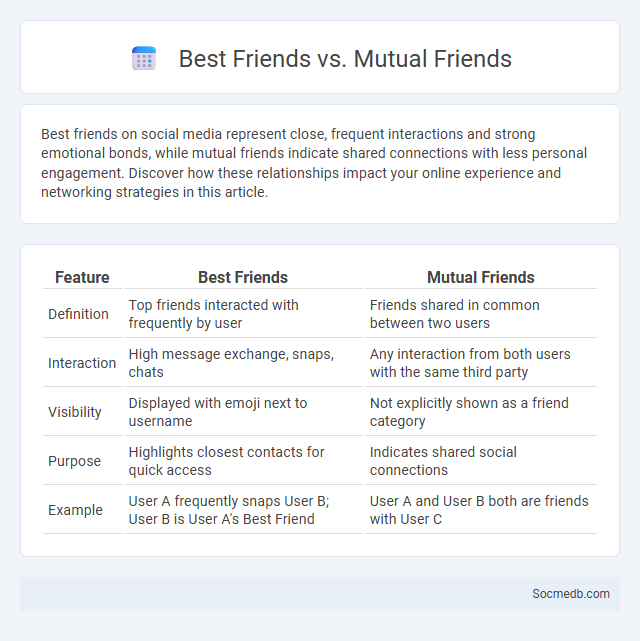
Photo illustration: Best Friends vs Mutual Friends
Best friends on social media represent close, frequent interactions and strong emotional bonds, while mutual friends indicate shared connections with less personal engagement. Discover how these relationships impact your online experience and networking strategies in this article.
Table of Comparison
| Feature | Best Friends | Mutual Friends |
|---|---|---|
| Definition | Top friends interacted with frequently by user | Friends shared in common between two users |
| Interaction | High message exchange, snaps, chats | Any interaction from both users with the same third party |
| Visibility | Displayed with emoji next to username | Not explicitly shown as a friend category |
| Purpose | Highlights closest contacts for quick access | Indicates shared social connections |
| Example | User A frequently snaps User B; User B is User A's Best Friend | User A and User B both are friends with User C |
Understanding Friendship Types: Best Friends, Mutual Friends, and Friends List
Understanding friendship types on social media involves distinguishing between best friends, mutual friends, and the general friends list to enhance online interactions. Best friends typically represent closest relationships with frequent communication, while mutual friends connect users through shared connections, facilitating network expansion. Managing the friends list effectively allows users to curate privacy settings and control content visibility based on varying levels of social proximity.
What Defines a Best Friend?
A best friend is defined by unwavering trust, consistent emotional support, and deep understanding shared across social media platforms. Genuine interactions, frequent meaningful communication, and authentic expressions of care distinguish best friends from casual online connections. These qualities foster a sense of reliability and closeness essential for lasting digital friendships.
Exploring the Concept of Mutual Friends
Mutual friends on social media platforms represent shared connections that link you with others, creating a bridge of trust and potential interaction. These relationships often enhance your network by providing common ground and increasing the likelihood of more meaningful engagement or collaboration. Understanding the dynamics of mutual friends can help you navigate social networks more effectively and expand your online community naturally.
The Role of a Friends List on Social Platforms
Your friends list on social media platforms acts as a curated network that influences content visibility and engagement by prioritizing updates from connected individuals. This list not only shapes personalized social feeds through algorithms optimized for relationship strength but also facilitates targeted communication and community building. Managing your friends list effectively enhances your digital experience by fostering meaningful interactions and protecting privacy settings tailored to trusted contacts.
Key Differences Between Best Friends and Mutual Friends
Best friends display deeper emotional bonds, frequent personal communication, and greater trust on social media platforms compared to mutual friends, who typically interact through shared connections or group settings. Profiles of best friends often showcase exclusive photos, private messages, and personalized interactions, while mutual friends' activities revolve around likes, comments, and occasional tagging in public posts. Algorithms on platforms like Facebook and Instagram prioritize content from best friends, enhancing visibility, unlike interactions with mutual friends that remain more casual and sporadic.
How Social Media Distinguishes Friends Categories
Social media platforms use algorithms and user interactions to categorize friends into groups such as close friends, acquaintances, and followers, enhancing personalized content delivery. Features like Facebook's "Close Friends" list or Instagram's "Close Friends" story sharing allow users to segment their audience based on intimacy and interaction frequency. This categorization helps optimize notifications, privacy settings, and content visibility, improving user engagement and social connection management.
Emotional Impact: Best Friends vs Mutual Friends
Emotional impact on social media interactions varies significantly between best friends and mutual friends, with best friends often providing deeper emotional support and more meaningful engagement through personalized messages and shared experiences. Mutual friends tend to generate broader social validation and occasional positive reinforcement, primarily through likes or comments that contribute to social presence without extensive emotional exchange. Studies highlight that interactions with best friends on platforms like Instagram or Facebook can enhance feelings of belonging and emotional well-being more effectively than interactions limited to mutual friends.
Privacy Settings and Your Friends List
Setting your social media privacy settings to limit access to your personal information is vital for protecting your online identity and controlling who can see your posts and profile details. Managing Your Friends List by regularly reviewing and removing unknown or inactive contacts reduces the risk of unauthorized access and potential data breaches. You should prioritize adjusting these settings to enhance your digital security and maintain a trusted online network.
Building Meaningful Connections: Quality over Quantity
Building meaningful connections on social media emphasizes engaging with authentic interactions rather than amassing a large number of followers. Prioritizing quality relationships fosters trust and loyalty, enhancing both personal and brand reputations. Deep and genuine engagement leads to higher impact and long-term community growth.
Choosing and Managing Friends Online
Choosing and managing friends online requires careful attention to privacy settings and personal boundaries to protect sensitive information. Prioritizing connections based on shared interests and trustworthiness enhances the quality of social interactions. Regularly reviewing and updating friend lists helps maintain a safe and positive online environment.
 socmedb.com
socmedb.com